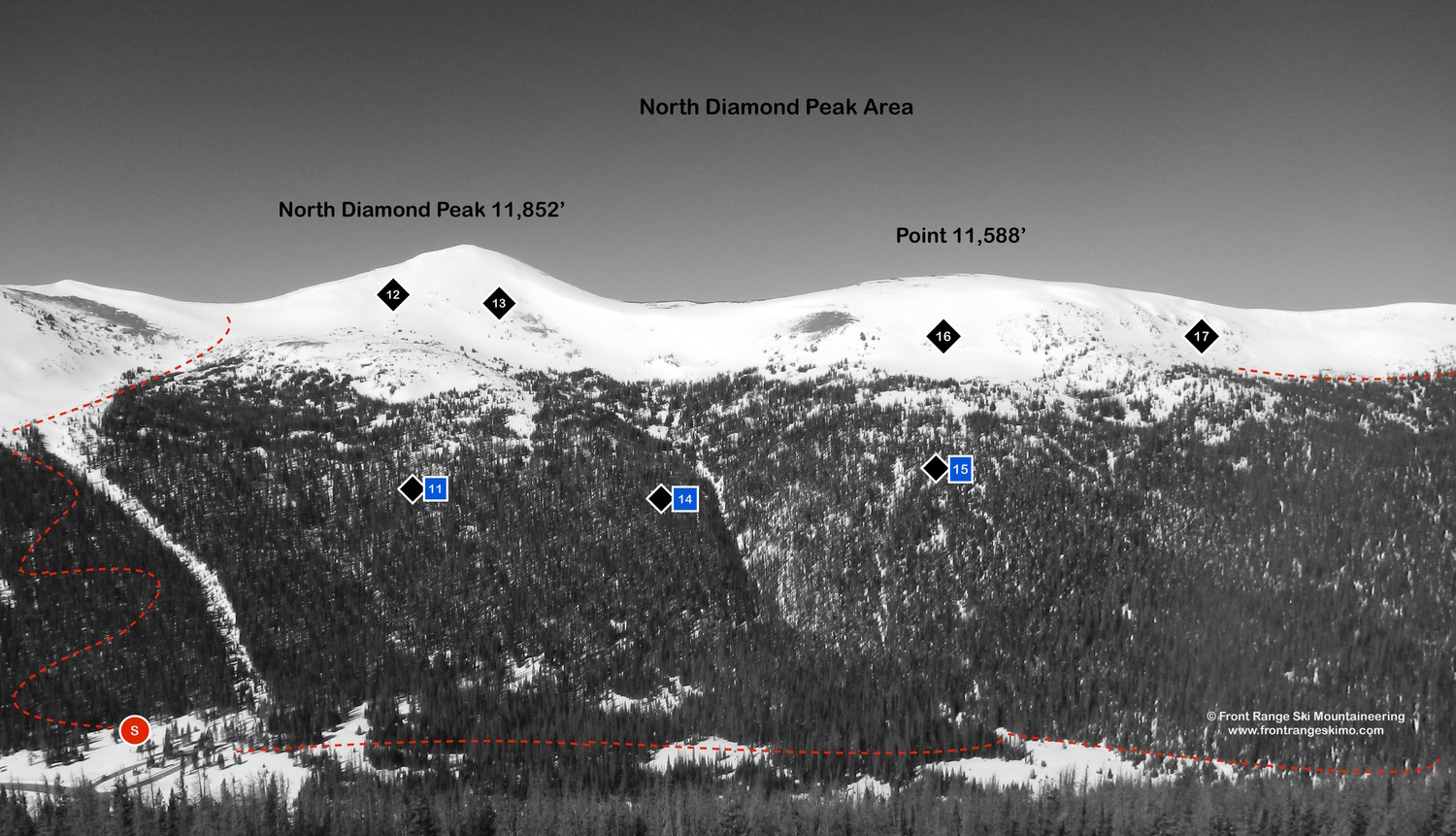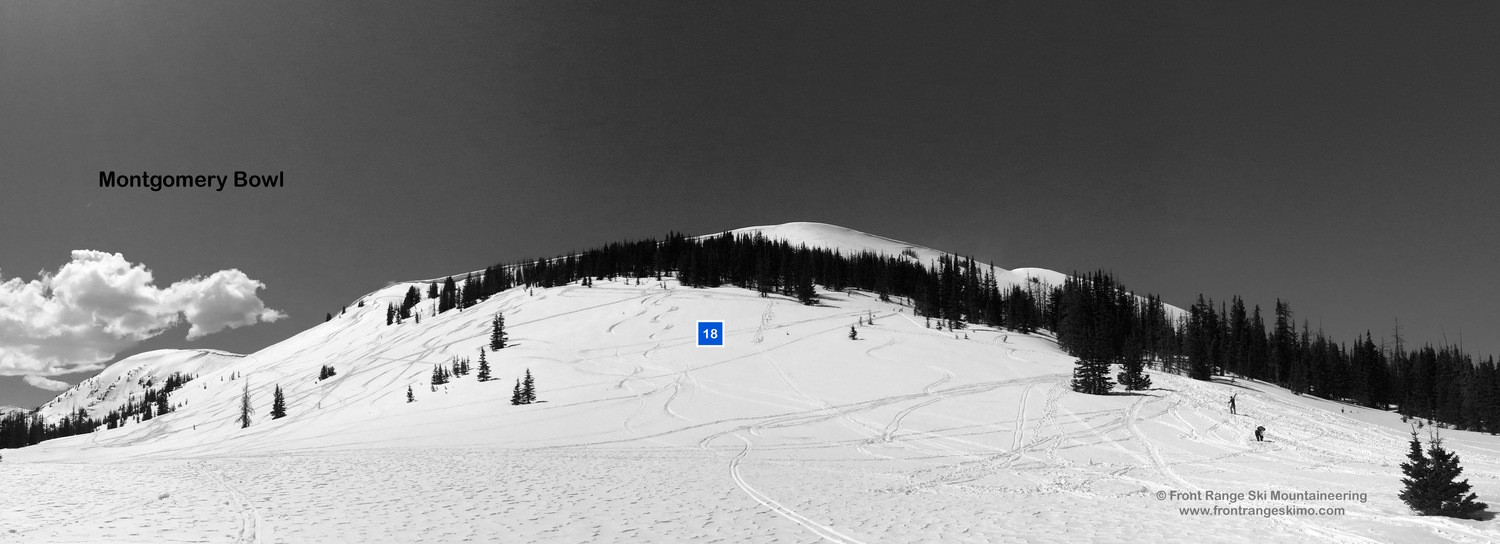Cameron Pass North
South Diamond Peak from the East. Photo: Rob Writz
Cameron Pass is the backcountry ski and snowboard zone for Fort Collins. The terrain around the pass is a massive area that holds numerous winter recreational opportunities including cross country skiing, snowshoeing, snowmobiling, and backcountry skiing. There is so much terrain in this area that it allows for these different recreational pursuits to be distributed across different trailheads and valleys.
The terrain described in this guide is just the tip of the iceberg at the broader Cameron Pass and Michigan River area. Once you get to the top of a peak or a good view you will find even more backcountry ski terrain in the distance. Most of the routes described here are visible from the roads. Although they are clearly visible, there is no car shuttling terrain in this area. You must be prepared to use skin or snowshoes to access these routes and make safe decisions for both your up-track and descent. This page has high-level information on the backcountry skiing and splitboarding in the Southern Medicine Bow Mountains and the heart of Cameron Pass: Montgomery Pass, North Diamond Peak, South Diamond Peak, and Montgomery Pass. See our page on Seven Utes Mountain for more skiing terrain on the west side of the pass.
The snowpack in the Cameron Pass area is historically fickle and dangerous. This area is plagued by the common Front Range wind and it scours and loads these slopes. Every route described here has the potential to avalanche. Be very careful here. Diamond Peaks Ski Patrol is a backcountry ski patrol at Cameron Pass offering search and rescue assistance as well as avalanche education courses. Looking for snow conditions in the Cameron Pass area? Try the Cameron Pass Snow Report for current snow, weather, and avalanche information.
Interested in more backcountry skiing around Cameron Pass? Check out Rodney Ley’s 2022 guidebook published by Beacon Guidebooks!
+ SOUTH DIAMOND PEAK ROUTES

South Diamond Peak is the epicenter of backcountry skiing at Cameron Pass. The access is quick and the terrain is diverse. This peak has a long skiing history and the locals have anointed nearly every gully and face with a name.
South Diamond Peak is a dangerous place to ski. High winds from multiple directions can cross load these complex slopes and there are massive avalanches each year on this northeast-facing slope. The area near the Wave and Gash slide every year. These slides run all the way into the trees and avalanche paths below, and the most catastrophic have reached the trailhead. The Bench is a large open area below these upper headwalls and it offers a false sense of security. It is not a safe place to be, and avalanches have been remotely triggered from here run into the trees. Consider waiting to ski South Diamond Peak in the spring once the snowpack has consolidated and become more predictable.
- Season: Winter
- Summit Elevation: 11,701’
- Aspect: East, Northeast
- Elevation Range: 10,276’ – 11,701’
- Vertical: 1,425’
- Trailhead: Cameron Pass (10,276’)
- Snowmobile Access: Snowmobiles are not used to access this part of Cameron Pass.
Skin Track:
The skin track to South Diamond Peak starts right at the trailhead. Look for a track heading southwest into the forest below South Diamond Peak. The exact direction of this commonly used track varies but it usually climbs quickly and steeply to tree line and into The Bench below South Diamond Peak. [40.5167, -105.9006]. From this point the skin track frequently traverses in a northwest direction along the edge of tree line and gaining the ridge between North and South Diamond Peak. It is approximately 1.25 miles and about1, 300’ from the trailhead to the saddle between the two peaks. If you can’t find the skin track to South Diamond Peak and you are going to set it yourself, make sure that you are ascending in the tightest trees on the way up and avoiding the avalanche terrain on the upper peak.
Exit:
The majority of the backcountry ski and snowboard routes on South Diamond Peak leave riders in a position to regain the trailhead. The routes directly below the summit can lead into the avalanche run outs that then descend t the trailhead or just to the south on Colorado Highway 14.
Routes:
1 - Taster’s Choice Trees - Taster’s Choice is the tree area on the South Shoulder of South Diamond Peak.
2 - Pap Smear - Pap Smear is the area skier’s left of Taster’s and after the trees. Like all of the routes off of the South Shoulder, it has a cornice at the top.
3 - The Wave - The Wave is a broad area between Pap Smear and the Gash. This area has a least one massive skier triggered or natural avalanche per year and these slides frequently propagate across the entire face including Pap Smear, Gash, and South Diamond’s Face.
4 - Gash - The Gash, AKA Avy Alley, is a distinct chute below the South Shoulder of South Diamond Peak.
5 - South Diamond Face - The main face of South Diamond Peak is a broad area leading into gullies, small cliffs, and convex slopes above the Bench.
6 - Ptarmigan - Ptarmigan is the broad slope on the far right of South Diamond Peak. This is one of the more popular lines on South Diamond Peak.
7 - Freeway - Freeway is a large avalanche slide below the routes on the South Shoulder of South Diamond Peak. The lower reaches of Freeway can take you to a large clearing next to Highway 14.
8 - Outhouse Gully - This is the long avalanche slide path from tree line below Ptarmigan to just above and behind the toilets at the trailhead.
+ NORTH DIAMOND PEAK ROUTES

North Diamond Peak is the slightly taller northern sibling of South Diamond Peak. This mountain is just slightly farther from the trailhead than South Diamond Peak. The eastern slopes of the mountain above Cameron Pass are not as steep as South Diamond, but can be equally as dangerous. A highlight of North Diamond Peak is the excellent tree skiing that awaits on the lower flanks of the mountain. This terrain offers numerous nooks and crannies to explore during storm snow and high avalanche hazard days.
- Season: Winter
- Summit Elevation: 11,852’
- Aspect: East
- Elevation Range: 10,276’ – 11,852’
- Vertical: 1,576’
- Trailhead: Cameron Pass (10,276’)
- Snowmobile Access: Snowmobiles are not used to access this part of Cameron Pass.
Skin Track:
Use the skin track up to The Bench on South Diamond Peak. Look for a track heading southwest into the forest below South Diamond Peak. The exact direction of this commonly used track varies but it usually climbs quickly and steeply to tree line and into the Bench below South Diamond Peak. [40.5167, -105.9006]. From this point the skin track frequently traverses in a northwest direction along the edge of tree line and gaining the ridge between North and South Diamond Peak. It is approximately 1.25 miles and about 1,300’ from the trailhead to the saddle between the two peaks.
Other skin tracks to North Diamond Peak develop during the winter. These are to the north of the trailhead and climb the trees below North Diamond Peak. The Cameron Connector cross country ski trail heads north from Cameron Pass’s trailhead and you can find uptracks leading from this direction to the terrain below North Diamond Peak. If this is your first time in the area you will want to take the main route described above to get your bearing straight for this area.
Exit:
The routes below North Diamond Peak frequently land on a track that you can use to skin or snowshoe back to the trailhead. The further north you go, the longer it takes to get back to the trailhead. There bed of Joe Wright Creek is in between you and Colorado Highway 14. Just above this creek bed you may find the “Cameron Connector”. This is a cross country ski and snowshoe trail connecting Cameron Pass and the Zimmerman Lake trailhead. It is marked with blue diamonds and following these to the south will take you back to Cameron Pass.
Routes:
11 - North Diamond Trees - North Diamond Trees are an expansive area of tree skiing below North Diamond Peak.
12 – North Diamond Peak Right – North Diamond Peak has two large snow slopes that diverge from the summit. Diamond Peak Right is the cornice capped slope oriented to the southeast that leads into the North Diamond Trees.
13 - North Diamond Peak Left- Diamond Peak Left is steeper than the “Right” route. This leads into drainage around Joe Wright Gully.
14 - Joe Wright Gully - Joe Wright Gully is a creek bed collecting skiers from North Diamond Peak and the trees below the South Bowl of Point 11,588’.
+ POINT 11,588' ROUTES

Point 11,588’ is a rise on the ridge between North Diamond Peak and the Montgomery Bowls. The terrain around this peak is an extension of the North Diamond Peak and Montgomery Pass bowl and tree skiing. The terrain is accessible from both the Zimmerman Lake Trailhead and Cameron Pass. It takes a little more effort to get in and out of this area and it is not as skied as intensely as South Diamond Peak and Montgomery Bowl.
This terrain on Point 11,588’ behaves similar to the other areas on this part of Cameron Pass. The upper bowls are avalanche terrain and large slides here have the potential to run into the trees below. The Northeast Bowl on 11,588’ is wind loaded and has a large convex slope at the top. Convex slopes like this are hanging weights just waiting for a trigger to release them into an avalanche on the ridges and gullies below.
- Season: Winter
- Summit Elevation: 11,588’
- Aspect: East, Northeast
- Elevation Range: 10,015’ – 11,588’
- Vertical: 1,573’
- Trailhead: Cameron Pass (10,276’) or Zimmerman Lake (10,015’)
- Snowmobile Access: Snowmobiles are not used to access this part of Cameron Pass.
Skin Track:
Use the skin tracks described for Montgomery Bowl or Cameron Pass. The South Bowl is more accessible from Cameron Pass and North Diamond Peak. You will probably ski North Diamond Peak to access the South Bowl. The Northeast Bowl is better accessed from Zimmerman Lake and the skin up to Montgomery Bowl. Later in the winter there may be skin tracks going up from the Cameron Connector cross country ski trail or other paralleling trails at the base of the mountain.
Exit:
The runs off of 11,588’ descend in an east or northeast direction. The Joe Wright Trees intersect Joe Wright Gully and large clearings at the bottom. The bottom of the Northeast Bowl descends into trees and gullies angled southeast. You could also traverse north from the bottom of the Northeast Bowl to the base of the Montgomery Bowls and return via this access trail or the surrounding tree runs. When you exit the trees at the base of this mountain the bed of Joe Wright Creek is in between you and Colorado Highway 14. Just above this creek bed you may find the “Cameron Connection”. This is a cross country ski and snowshoe trail that is marked with blue diamonds and connects Cameron Pass trailhead (to the south) and the Zimmerman Lake trailhead (to the north).
Routes:
15 - Joe Wright Trees: The Joe Wright Trees are a broad and fun glade below the South Bowl. This area descends into Joe Wright Gully and the trees and glades are a good place to ski during high avalanche time.
16 - South Bowl – The South Bowl is more moderate than the Northeast Bowl but it is still and avalanche slide area. The skier’s right side is frequently windswept and shallow. The skier's left side is steeper and holds a wind-loaded convex hump.
17 - Northeast Bowl –The Northeast Bowl is complex and dangerous. There are four or five gullies in the bowl that are separated by ridges and cliffs. The convex slope at the top presents a challenging snow safety hazard.
+ MONTGOMERY PASS ROUTES

Montgomery Pass and the bowls surrounding it are very popular places to ski and splitboard at Cameron Pass. This is frequently the first place for newcomers to ski at Cameron Pass. The access is simple, the runs are quick, and the trail is well marked.
The majority of the ski terrain is south of Montgomery Pass. The Pass itself is a high and windswept saddle on the southern Medicine Bow Mountains. This guide briefly describes the Montgomery Pass Bowls. There is ample touring and skiing terrain north of the pass, and you can get a great view of this on a sunny day from the top of Montgomery Bowl. Just to the east of the base of Montgomery Bowl puts you on top of fun tree shots and a creek bed that descend towards Joe Wright Creek and Highway 14. Another great adventure in this area to stay overnight on the west side of the range at Never Summer Nordic’s Montgomery Pass Yurts.
Montgomery Bowl is receives heavy ski, snowboard, and snowshoe traffic. Despite frequent use, the Bowl and the terrain surrounding it are in avalanche terrain. Do not be fooled by the moderate nature of the Bowl. The Bowl is wind loaded and lined with cornices. Always be aware in avalanche terrain.
- Season: Winter
- Summit Elevation: 11,408’
- Aspect: East, Northeast
- Elevation Range: 10,015’ – 11,408’
- Vertical: 400’
- Trailhead: Zimmerman Lake (10,015’)
- Snowmobile Access: Snowmobiles are not used to access this part of Cameron Pass.
Skin Track:
The climb to Montgomery Pass starts across the street from the Zimmerman Lake trailhead. Walk to the north end of the Zimmerman Lake pullout and cross the road to the sign for the Montgomery Pass Trail. This well-defined trail follows blue blazes and climbs approximately 2 miles to the bottom of the bowls. [40.5385, -105.9013] Before reaching the bowls there is a junction with signs directing you south to the bowls or west to Montgomery Pass itself.
Exit:
The most common exit from the Montgomery Pass area is to follow the trail back to the trailhead. If you ski the tree shots to the south of the trail and attempt to ski down to Highway 14, look for the “Cameron Connection”. This is a cross country ski and snowshoe trail connecting Cameron Pass and the Zimmerman Lake trailhead. It is marked with blue diamonds and following these markers to the north will take you back to the Zimmerman Lake Trailhead.
Routes:
18 - Montgomery Bowl – Monty Bowl is the classic Cameron Pass fun zone. The runs are short, but the snow is often high quality. There is a section of trees climbing up to the cornice at the top of the Bowl. The Bowl is obvious and several more minutes of climbing above the signed turn on the Montgomery Pass trail.
19 - Montgomery Bowl North – The bowl skiing continues to the north of Monty Bowl. This is avalanche terrain and the run leads into a large slide path. The trees below this lead into tree skiing and an east trending creek bed that intersects Highway 14 about a quarter mile to the north of Zimmerman Lake Trailhead.
+ HOT DOG BOWL ROUTES

Hot Dog Bowl is located on the east side of Highway 14 near Cameron Pass. This area has a selection of terrain and ranges from lower angle tree and bowl skiing to steep avalanche prone slopes. You could spend a full day here skiing multiple laps on this north-facing bowl. Hot Dog Bowl is inside the Neota Wilderness, and the views of the Cameron Pass region from the top of the bowl are worth the trip in. Hot Dog Bowl has direct access from the Zimmerman Lake trailhead, and does not see the crowds that frequent Montgomery Pass and South Diamond Peak.
The west side of Hot Dog Bowl contains significant avalanche hazard. This slope is steep and on the leeward side of the mountain. There is significant wind loading of snow onto this slope and it should only be skied under very stable conditions. This slope frequently slides and Hot Dog Bowl has seen several accidents including one fatality.
You can get a glimpse into Hot Dog Bowl when driving south on Highway 14 from Cameron Pass. At the parking for Joe Wright Reservoir look south to see the top of the bowl. You can pull out at Joe Wright and survey the terrain from there.
- Season: Winter
- Summit Elevation: 11,359’
- Aspect: North, East
- Elevation Range: 10,015’ – 11,359’
- Vertical: Bowl: 600’, Hamburger Trees: 1,345’
- Trailhead: Zimmerman Lake (10,015’)
- Snowmobile Access: Snowmobiles are not allowed in the Neota Wilderness.
Skin Track:
The access to Hot Dog Bowl starts with the Zimmerman Lake winter trail. The signs for this trail are south of the restrooms at the trailhead. Follow this road for a short 0.1 miles to where the road curves sharply to the northeast. [40.5381, -105.882] From this point head into the woods on a south trajectory. This uptrack in this area may not be obvious and filled in with snow. The routes frequently into Hot Dog Bowl follow either the creek bed draining the bowl, or climbing Hamburger Tree’s blunt ridge directly south. Regardless of which way you take it is approximately 1.5 miles from the trailhead to the top of the bowl.
Exit:
Follow the creek bed draining the Hot Dog Bowl back to the trailhead and the highway. Hamburger Trees can exit into this creek bed or near Zimmerman Lake trailhead. When descending the creek bed, stay to the skier’s left side of the creek until lower down in the flats. Look for a place to cross over here. Routes:
20 - Hot Dog Bowl East – The east side of Hot Dog Bowl contains tree shots and gullies that have lower avalanche hazard than the west side of the bowl. From the center of the bowl there are numerous short and fun lines dropping into the trees and the creek bed.
21 - Hot Dog Bowl West – The western edge of Hot Dog Bowl is a wide and steep slope that is heavily wind loaded. This is open terrain and further skier’s left has several rock spines and spread out trees.
22 - Hamburger Trees – Hamburger Trees are a located to the skier’s left of Hot Dog Bowl West. There are open glade turns at the top leading to tree skiing in the middle and bottom. This tree run exits into the creek bed or near Zimmerman Lake trailhead. If you drop to the west side of Hamburger Trees you will exit the forest further south on Highway 14.
+ TRAILHEADS
Cameron Pass (10,276’)
This trailhead is right at the top of the pass and provides immediate access to North and South Diamond Peaks. There are restrooms at the pass to help relieve your long drive from Fort Collins. The trailhead itself is a horseshoe shaped pull off on the west side of Highway 14. Cameron Pass is about 68 miles from Fort Collins and about 31 miles from Walden on Highway 14. [40.5201, -105.893]
Zimmerman Lake (10,015’)
Zimmerman Lake trailhead is a large pullout on the east side of Highway 14 north of Cameron Pass’s summit. There are restrooms at this trailhead along with ample parking. Zimmerman Lake trailhead is 67 miles from Fort Collins and about 32 miles from Walden on Highway 14. [40.5395, -105.8824]
+ MAPS & PICTURES
Below we have included a link to a Google interactive map and a curated list of photos of the mountain.














